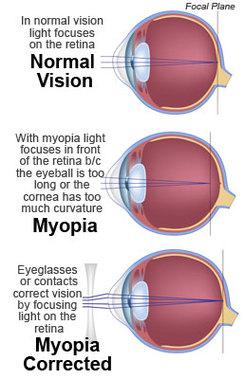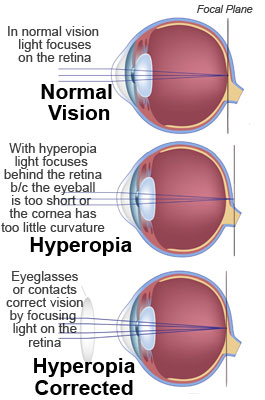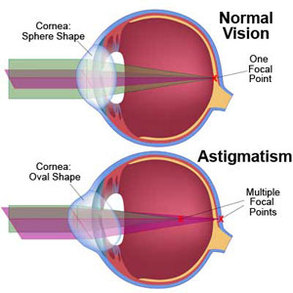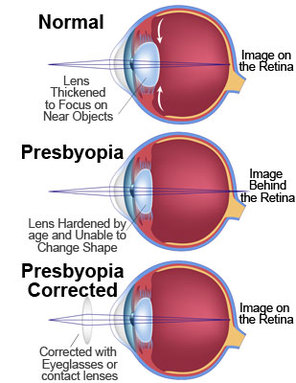|
|
|
NEARSIGHTEDNESS (MYOPIA)
what causes nearsightedness?Nearsightedness occurs if the eyeball is too long or the cornea, the clear front cover of the eye, has too much curvature. As a result, the light entering the eye isn’t focused correctly and distant objects look blurred.
what are the treatment options?A comprehensive optometric examination will include testing for nearsightedness. An optometrist can prescribe eyeglasses or contact lenses that correct nearsightedness by bending the visual images that enter the eyes, focusing the images correctly at the back of the eye. Depending on the amount of nearsightedness, you may only need to wear glasses or contact lenses for certain activities, like watching a movie or driving a car. Or, if you are very nearsighted, they may need to be worn all the time.
Another option for treating nearsightedness is orthokeratology (ortho-k), also known as corneal refractive therapy. It is a non-surgical procedure that involves wearing a series of specially designed rigid contact lenses to gradually reshape the curvature of your cornea. The lenses place pressure on the cornea to flatten it. This changes how light entering the eye is focused. |
what is nearsightedness?Nearsightedness (myopia) is a vision condition in which close objects are seen clearly, but objects farther away appear blurred. Generally, nearsightedness first occurs in school-age children. Because the eye continues to grow during childhood, it typically progresses until about age 20. However, nearsightedness may also develop in adults due to visual stress or health conditions such as diabetes.
what are some signs of nearsightedness?A common sign of nearsightedness is difficulty with the clarity of distant objects like a movie or TV screen or the chalkboard in school.
|
Laser procedures are also a possible treatment for nearsightedness in adults. They involve reshaping the cornea by removing a small amount of eye tissue. This is accomplished by using a highly focused laser beam on the surface of the eye.
For people with higher levels of nearsightedness, other refractive surgery procedures are now available. These procedures involve implanting a small lens with the desired optical correction directly inside the eye, either just in front of the natural lens (phakic intraocular lens implant) or replacing the natural lens (clear lens extraction with intraocular lens implantation). These procedures are similar to one used for cataract surgery patients, who also have lenses implanted in their eyes (intraocular lens implants).
For people with higher levels of nearsightedness, other refractive surgery procedures are now available. These procedures involve implanting a small lens with the desired optical correction directly inside the eye, either just in front of the natural lens (phakic intraocular lens implant) or replacing the natural lens (clear lens extraction with intraocular lens implantation). These procedures are similar to one used for cataract surgery patients, who also have lenses implanted in their eyes (intraocular lens implants).
FARSIGHTEDNESS (HYPEROPIA)
what is farsighteness?Farsightedness (hyperopia) is a vision condition in which distant objects are usually seen clearly, but close ones do not come into proper focus.
The majority of children are born hyperopic, but through the process of emmetropization – their eyes gradually become less farsighted often eliminating the need for glasses. Emmetopization does not always occur or may not occur to the degree that will allow for good or comfortable vision without correction. Children and adults are at risk for hyperopia, especially those that have parents that are hyperopic as there is a genetic factor which increases the risk for farsightedness |
what causes farsightedness?Farsightedness occurs if your eyeball is too short or the cornea has too little curvature, so light entering your eye is not focused correctly.
what are the symptoms?Common signs of farsightedness include difficulty in concentrating and maintaining a clear focus on near objects, eye strain, fatigue and/or headaches after close work, aching or burning eyes, irritability or nervousness after sustained concentration.
will vision screenings detect farsightedness?Common vision screenings, often done in schools, are generally ineffective in detecting farsightedness. A comprehensive optometric examination will include testing for farsightedness.
In mild cases of farsightedness, your eyes may be able to compensate without corrective lenses. In other cases, your optometrist can prescribe eyeglasses or contact lenses to optically correct farsightedness by altering the way the light enters your eyes. |
ASTIGMATISM
what are the effects of astigmatism?Astigmatism is a vision condition that results in blurred vision due either to the irregular shape of the cornea (the clear front cover of the eye) or sometimes it is due to the curvature of the lens inside the eye.
An irregular shaped cornea or lens prevents light from focusing properly on the retina, the light sensitive surface at the back of the eye. As a result, vision becomes blurred at any distance. how common is astigmatism?Astigmatism is a very common vision condition. Most people have some degree of astigmatism. Slight amounts of astigmatism usually don’t affect vision and don’t require treatment. However, larger amounts cause distorted or blurred vision, eye discomfort and headaches.
Astigmatism frequently occurs with other vision conditions like nearsightedness (myopia) and farsightedness (hyperopia). Together these vision conditions are referred to as refractive errors because they affect how the eyes bend or “refract” light. |
what causes astigmatism?The specific cause of astigmatism is unknown. It can be hereditary and is usually present from birth. It can change as a child grows and may decrease or worsen over time.
|
what are my treatment options?
A comprehensive optometric examination will include testing for astigmatism. Depending on the amount present, your optometrist can provide eyeglasses or contact lenses that correct the astigmatism by altering the way light enters your eyes.
Another option for treating astigmatism uses a corneal modification procedure called orthokeratology (ortho-k). It is a painless, non-invasive procedure that involves wearing a series of specially designed rigid contact lenses to gradually reshape the curvature of the cornea.
Laser surgery is also a possible treatment option for some types of astigmatism. It changes the shape of the cornea by removing a small amount of eye tissue. This is done using a highly focused laser beam on the surface of the eye.
Another option for treating astigmatism uses a corneal modification procedure called orthokeratology (ortho-k). It is a painless, non-invasive procedure that involves wearing a series of specially designed rigid contact lenses to gradually reshape the curvature of the cornea.
Laser surgery is also a possible treatment option for some types of astigmatism. It changes the shape of the cornea by removing a small amount of eye tissue. This is done using a highly focused laser beam on the surface of the eye.
PRESBYOPIA (OVER 40)
what are the symptoms of presbyopia?People commonly mistake the symptoms of presbyopia for farsightedness. However, the two conditions have different causes: farsightedness is a result of a misshapen cornea, whereas presbyopia is due to the loss of flexibility in the lens.
Presbyopia is a natural occurrence where near vision becomes blurred, making it hard to focus while doing things like reading, using a cell phone, working on the computer, or doing anything that requires near vision. It is not a disease or illness; in fact, it is very common with age. what are the treatment options?Depending on the individual, presbyopia may be treated with corrective eyeglasses or contacts, or with refractive surgery. While bifocal lenses used to be a widely used option, today’s progressive-addition lenses (PALs) can offer a popular alternative. Often referred to as “no-line bifocals – because the gradual curves eliminate visible lines – PALs don’t just provide a vision correction for near and far, but also a smooth transition between all different distances.
|
what is presbyopia?As you get older, the lenses inside your eyes slowly lose their ability to focus at varying distances. You may start to have trouble viewing objects that are close to you, and even find yourself holding your reading material at an arm’s length to help you focus. You may also experience eye strain and fatigue. Known as presbyopia, this common condition can be detected early through a comprehensive eye exam.
what causes presbyopia?In young people, the eye’s lens is soft and flexible, readily changing shape to see images from different distances. As you age, the crystalline lens in your eye hardens and loses elasticity. With this loss of flexibility, your eyes are less able to adjust properly to focus near objects.
|
Did you know? |
You can look upwards to see objects far away, straight ahead to see things that are in your immediate area, and downwards to focus on very close or fine objects. Unlike “reading glasses,” the right pair of PALs can allow you to wear one pair of glasses for most of your daily activities.
Some glasses and contacts also address specific occupational needs – such as computer usage. Make sure to talk to your eye care professional to determine what type eye wear will best suit your lifestyle needs.
Some glasses and contacts also address specific occupational needs – such as computer usage. Make sure to talk to your eye care professional to determine what type eye wear will best suit your lifestyle needs.







